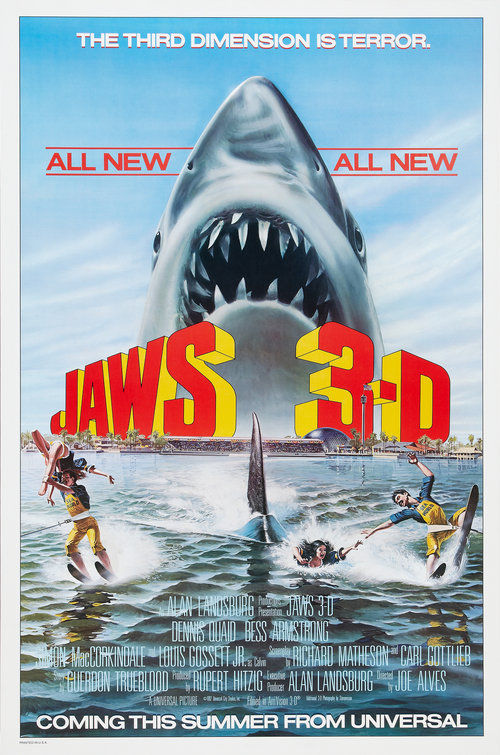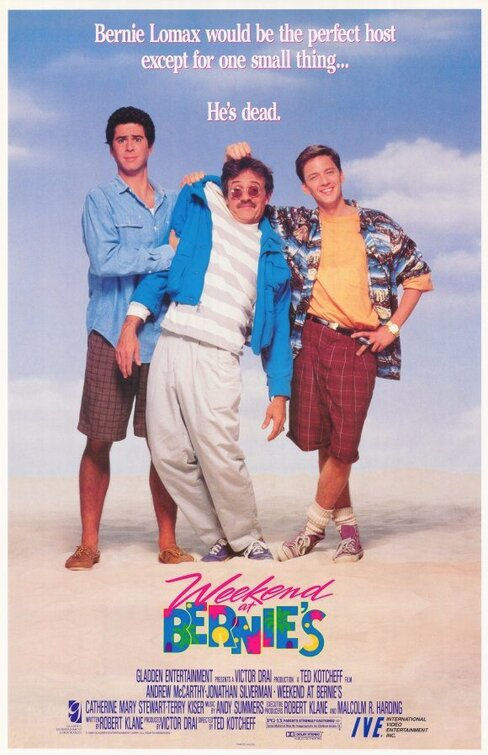A Look Back at the “Jaws” Sequels - "Jaws" 50th Anniversary
- Matt Palmer
- 3 days ago
- 7 min read

A while back I took a look at the 1975 classic blockbuster “Jaws” for its 50th anniversary. And since the Dietrich Theater is in the middle of showing the classic film for its anniversary, I decided to check out the remaining films of the franchise!

In the 1978 sequel “Jaws 2,” years after the shark attacks that left Amity Island reeling, Sheriff Martin Brody finds new trouble lurking in the waters. Mayor Vaughan wants to rid the beach town of the stain of this reputation.
But the disappearance of a pair of divers suggests that all is not right. When Brody voices his warnings about holding a sailing competition, everyone thinks it’s just post-traumatic stress.
That is, until a shark fin cuts through the water.
Now, even though “Jaws 2” isn’t nearly as great as the 1975 classic, it’s still a fairly solid entry of the franchise and is easily the best of the sequels (which really isn’t that hard to do). While some of this sequel seems like a simple re-hash of the original, “Jaws 2” still does a decent job giving us a few more good shark scares.
One of the best moments of this sequel is during a shark attack where some gas ends up getting spilled on a boat (which, of course, explodes) that also gives the nearby shark some burn scars that gives the shark a more menacing look. There’s also an intense helicopter rescue attempt involving teens and the shark circling around that can be really suspenseful.
In the 1983 sequel “Jaws III” (a.k.a. “Jaws 3D”), after a young great white shark finds its

way into a sea-themed park, workers try to capture it. But the facility’s attempt to keep the shark in captivity has dire consequences.
A much larger mother shark appears in search of its offspring. Among those who must battle the angry aquatic killing machine are marine biologist Kathryn Morgan, her co-worker Mike Bordy and a pair of friendly dolphins.
The third “Jaws” movie is where the franchise starts its decline and even though it’s a weaker sequel, it’s one of those movies that has a “so bad it’s good” vibe which can easily make this a guilty pleasure.
While the movie’s premise of a shark trapped in a theme park does sound fun and enjoyable, “Jaws III” isn’t nearly as exciting as the first two movies and the shark is definitely not nearly as convincing and is actually kind of laughable.
Also, unlike the previous entries, the third movie doesn’t really have any truly memorable moments and the effects (even for that time) aren’t really that good at all.

Now, it’s time to get into the worst of the sequels - “Jaws: The Revenge.” The family of widow Ellen Brody has long been played by shark attacks, and this unfortunate association continues when her son is the victim of a massive great white.
In mourning, Ellen goes to visit her other son, Michael, in the Bahamas, where she meets Hoagie. As they begin a relationship, a huge shark appears off the coast of the island, and Ellen’s trouble with the great white begins again.
Even though “Jaws III” wasn’t really that good and can be “so bad it’s good,” it’s nothing compared to “Jaws: The Revenge,” which is so bad it’s … well bad. The effects for this sequel really aren’t great at all and the shark attack scenes lack any tension that should be part of the scenes.
This sequel’s story is also bad. For example, Ellen Brody, the widow of Chief Brody, gets some sort of psychic connection with the shark that killed her younger son and can somehow sense at times when the shark is near. There’s also a part of the plot where she believes that the same shark is seeking revenge on the family. Oh, and the shark roars at the end.
The only positive thing about “Jaws: The Revenge” is that Michael Caine (who probably knew he was in a terrible movie) is still trying to have a good time in this movie and can be the most entertaining part of this sequel.
You can currently stream the entire “Jaws” franchise on Netflix!
The movie's tagline "Just when you thought it was safe to go back in the water . . . ", became one of the most famous and popular taglines in motion picture history. The blurb has frequently been spoofed and referenced in both social vernacular and in other movie promotions as well.
Marc Gilpin (Sean Brody) claims that when they were shooting one of the scenes on the makeshift raft of wrecked yachts, they were being circled by a real hammerhead shark. The actors were scared and began to scream and holler at the production crew, which was filming that particular scene from a distance. The crew was oblivious to the danger and assumed the actors were simply "in character" and gave them the thumbs up.
Roy Scheider did not originally want to appear in this film, but had recently left the production of The Deer Hunter (1978), which led to conflicts with Universal Pictures, with whom he was locked into a multi-film contract. The studio agreed to forgive his leaving The Deer Hunter (1978) if he did this film, which they would count as the two remaining films of his contract with them. Scheider agreed to the terms, but was resentful of his involvement from the outset and clashed frequently with director Jeannot Szwarc.
Many scenes had to be shot in the fall/winter months. As such, the actors had to suck ice cubes prior to takes to avoid having their breath seen on camera.
Murray Hamilton's scenes were shot quickly because his wife was about to undergo a biopsy for cancer at the time and he wanted to be with her.
Surpassed The Spy Who Loved Me (1977) as the highest-grossing sequel worldwide, and held the record until surpassed by Rocky II (1979), which itself was surpassed a year later by Star Wars: Episode V - The Empire Strikes Back (1980).
Steven Spielberg and Richard Dreyfuss were approached to direct and star in the sequel but production on Close Encounters of the Third Kind (1977) was running behind and they declined to participate.
According to the book "Roy Scheider: "A Film Biography" (2002) by Diane C. Kachmar, Scheider, who starred in the first two Jaws movies, once said, "Mephistopheles couldn't talk me into doing (it). They knew better than to even ask." Reportedly, Scheider agreed to make Blue Thunder (1983) in order to ensure that he was definitely and contractually unavailable for this film. Scheider had made Jaws 2 (1978) reluctantly due to a contract issue with Universal Pictures, whereby he owed the studio two films after withdrawing from The Deer Hunter (1978). To get out of this situation, he opted to do Jaws 2 (1978), a movie on which he didn't want to work, in exchange for the studio releasing him from his contract.
David Brown and Richard D. Zanuck, producers of the first two films, originally pitched this as a spoof, based on a suggestion by Matty Simmons and John Hughes. Titled "National Lampoon's Jaws 3, People 0", it was about a movie studio trying to make a second sequel to Jaws (1975). It opened with author Peter Benchley being eaten in his pool by a shark, and included a naked Bo Derek and shark-costumed aliens. Joe Dante was attached as director. Steven Spielberg rejected the idea and threatened to walk from his deal with Universal. When Zanuck and Brown learned of the rejection, they quit the studio.
The filmmakers initially planned to have very few "pop-out" effects where objects extend beyond the screen in 3-D. Studio executives ultimately pressured them to include more, worried that audiences would leave disappointed and spread bad word-of-mouth if the 3-D were used mainly for depth.
The film was also shown in a standard 2D widescreen theatrical, with the name revised to just Jaws 3 (no D). With the processes to remove the stereoscopic imaging, there are some strange (analogue) optical quirks, such having strange blurring on the edge of the frame, as well as an odd color palette not unlike the early Technicolor process. Additionally, in 2D it is sometimes blatantly clear which shots are meant to be the "popcorn dropping" 3D money shots, with the exaggerated depth of field with forward, mid and distance perspectives.
This was the first sequel nominated for the Golden Raspberry Award for Worst Picture.
Michael Caine said "Won an Oscar, built a house, and had a great holiday. Not bad for a flop movie." He was paid $1.5 million for seven days work in the Bahamas, and the schedule was so tight that the producers were unable to spare him so he could attend the Academy Awards, and he went on to win the Best Actor in a Supporting Role Oscar for Hannah and Her Sisters (1986).
Lorraine Gary briefly came out of retirement to reprise the role of Ellen Brody. This film stands as her final acting role to date.
Murray Hamilton was asked to reprise his role as the Mayor in a short appearance at the beginning of this movie, however, he died of cancer before filming started.
A crucial subplot involved Hoagie smuggling drugs onto the island. The scenes were shot, then deleted during post-production, because it took away from the main premise involving the shark. It's fully detailed in the novelization.
This movie is listed amongst the 100 Most Enjoyably Bad Movies Ever Made in John Wilson's book "The Official Razzie® Movie Guide."
According to director Joseph Sargent the film had gone through so many story pitches that once they were settled on the preposterous idea of the shark actually seeking revenge on the Brody family they were just so burned-out creatively that being given the go-ahead from Universal made everyone happy and excited. Everyone was aware of how ridiculous the concept was, but thought there was a fair chance of making it work for the screen.
The film, compared to its predecessors which were box-office successes, underperformed and only made $51.9 million off a $23-million budget. The much ridiculed plot was so poorly received that stand-up comedians dedicated their entire acts to spoofing this movie after it came out. All of this led to Universal abandoning any plans for further sequels.
The website "TV Tropes" coined the term "voodoo shark," which is defined as an attempt to explain away a plot hole that ends up falling flat. The name of the trope refers to a deleted plot point from this film, that was retained in the film's novelization, which explained the shark's motivation being the result of a curse by a voodoo witch doctor seeking revenge on the Brody family after a scuffle with Michael.







Comments